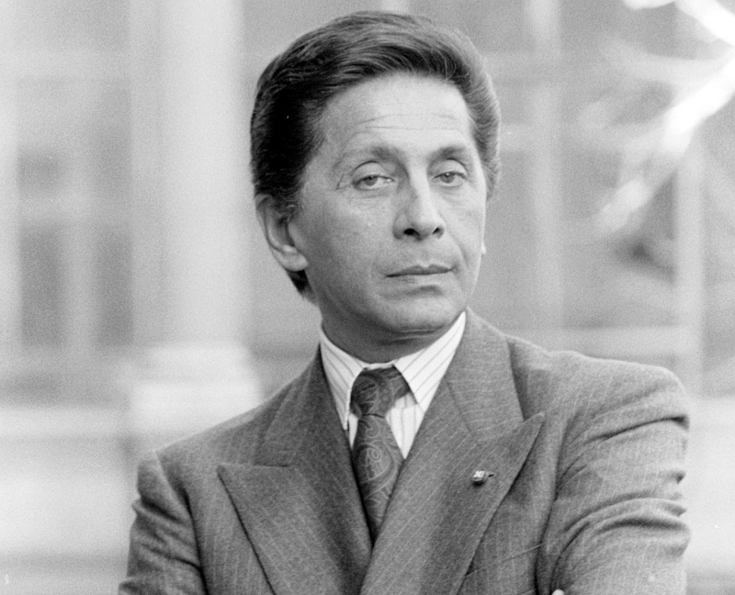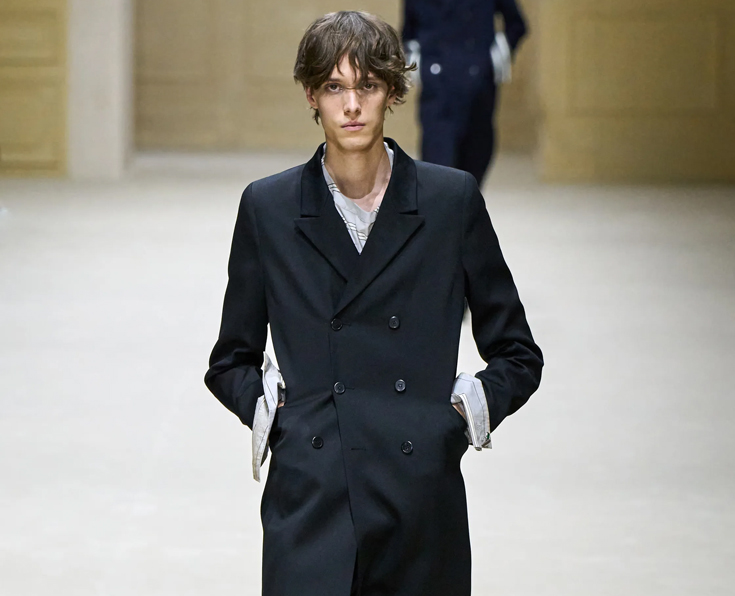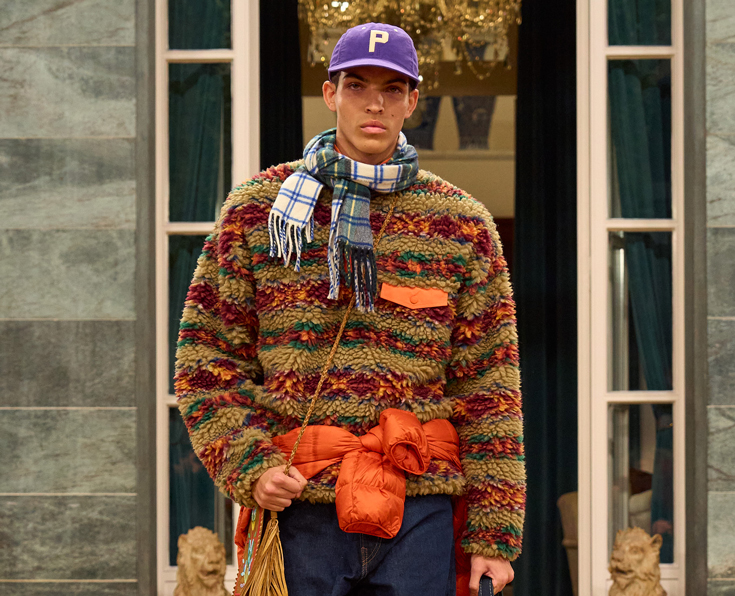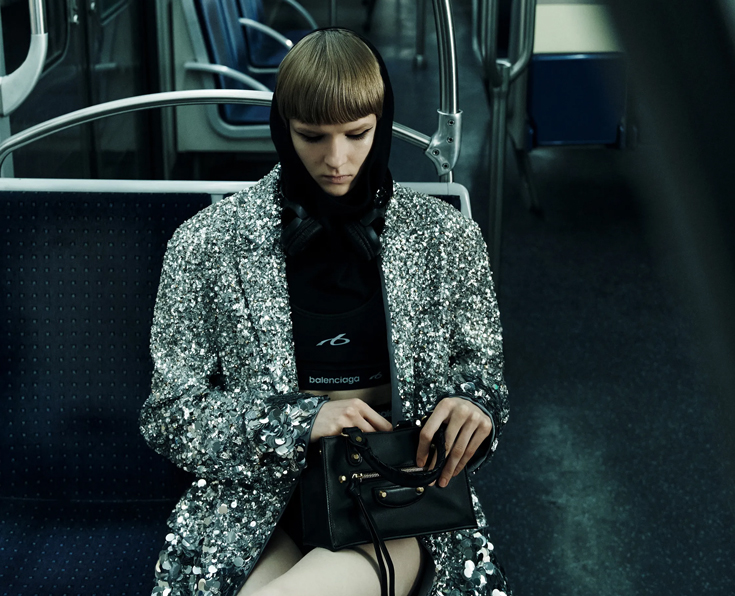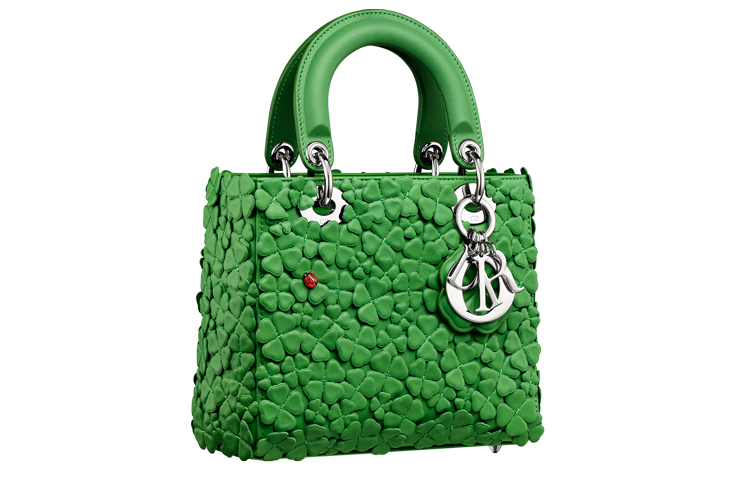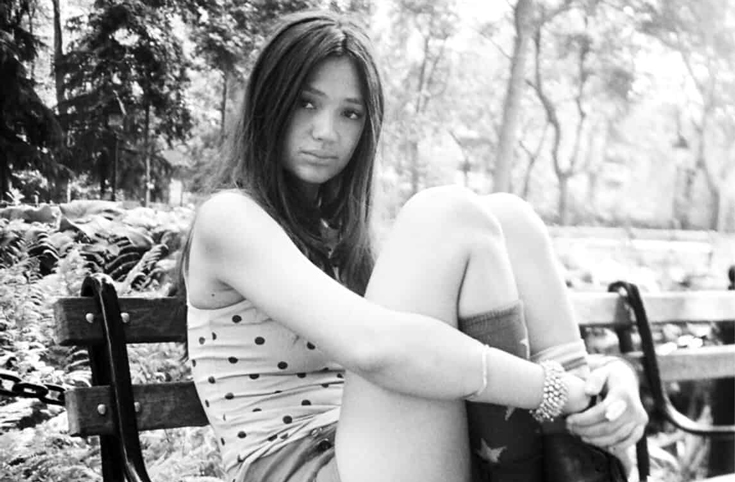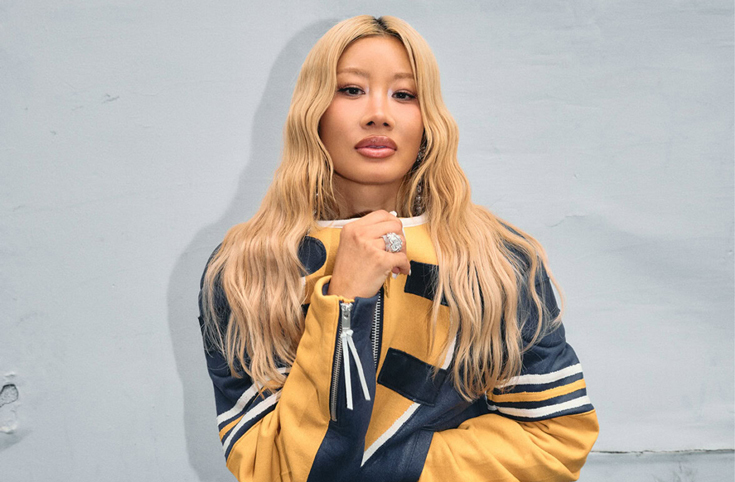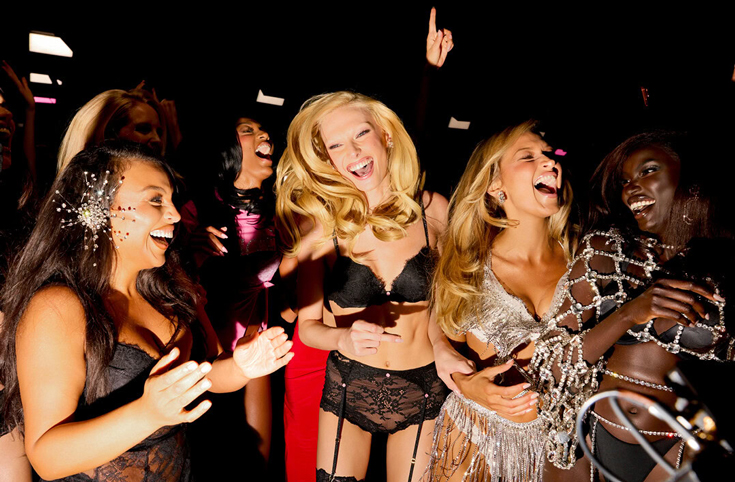TEN QUESTIONS WITH JORDAN GOGOS

Jordan Gogos is making major moves at Australian Fashion Week. The designer has collaborated with esteemed Japanese-Australian designer Akira Isogawa on a new collection, unearthing a new sphere the universe of Iordanes Spyridon Gogos. The otherwordly Japanese poetry of Akira's clothes meets Jordan's fresh youthfulness. We spoke to Jordan about how the collaboration came to be, the sustainability factor and the evolution of his brand:
How did the collaboration with Akira happen? What do you love about his work? What have you learnt from him?
"The collaboration with Akira built over time, it never started with the concept of wanting to do a whole show together. It’s because of his rich history I just wanted to meet him, understand his skill, and simply connect.
Akira’s body of work is a source of inspiration for me, and the importance grew the more I saw his archive and the techniques involved. After connecting, it just organically evolved and became the collection we presented.
Being at the beginning of your career, you need to be able to expand your skills and knowledge, and there is only so far you can go without someone that is a true master in their field. From a personal perspective, he's allowed me to understand and normalize the tension points between commercializing your work and art, but also being uncompromising in both. From a technical perspective, I found a lot of similarities in the things that we both do for a collection, and I found this quite assuring for myself. For example, I twist fabric but don’t take it into the world of coiling as he does. I embellish but don’t do beading. It was interesting to work on new techniques, but more interesting to just sit back and watch his skills come to life.
From a career perspective, I've learnt that certain things I’ve been through as a young designer, well-established ones like Akira still continue to experience. Certain challenges that remain even with a long-standing 30+ year career like Akira’s, and the whole point is to tackle them and overcome them."
What was inspiring you when you were designing this collection?
"In general, Denim is a really big inspiration and focus for me, it always acts as a starting point because denim, as a fabric, is like a blank page. It can be seen as a version of storytelling – for example, the more worn out a pair of jeans is, the more you can tell the character of the person wearing it. A brand-new pair would definitely not be owned by a laborer, or even ones with holes by the knees. Each piece of denim fabric can tell a story just by manipulating it. And I think this idea kind of trickles through all the different fabrics that I work with because denim acts as my prototype of how I want to approach materiality. All of the denim pieces we’ve created in our past shows have been acquired by galleries or museums, so there’s definitely a universal language that follows the material.
Yes, there are couture pieces in the show, and sometimes when people think of couture, they think of something that’s unattainable. But what's so interesting about denim is it's accessible to everybody. I enjoy working with it, I also love it generally as it resonates on a strong level with everybody, for example not everyone has the same connection with tulle.
I find inspiration in starting off with fabrics that people can relate to and turning them into something creative. I'm also excited because we’ve used our compressing method on denim for this year’s show, and we’ve also got denim prints incorporated into the upcoming ready to wear collection.
Akira Isogawa was a major source of inspiration for this collection, the marrying of both our brands’ logos, the Iordanes Spyridon Gogos Trojan horse, and Akira’s iconic Teddy Bear from 2003 and reviving that into the runway really set the tone for the whole show."
What was the catalyst from the inspiration? What made the leap from the mood board into the collection?
"Firstly, I don’t do mood boards. But I would say that I used Akira’s studio as a source of inspiration. Seeing Akira standing in front of me and his 30-year-old fashion archive behind him. It’s an archive like no other, there are pieces from across the years pulled out and lying in different parts of the studio and haven't made their way back to where they should be, mixing pieces from one collection with the other, and resulting in visually stunning looks that certainly inspired our collaboration.
I would have ideas, and he would say come see this and show me a piece on how he executed a similar idea in a different way, which we then later utilised for this collection. The initial stages were really like a bounce board, trying to get to that springboard towards knowing that this type of style exists and has existed on runways but throwing myself into finding a way to utilise it that hasn’t been seen or done before. It was a challenge, but one that I actually enjoyed. With his archive collections, my previous pieces, my materials, his techniques, everything was like springboarding off into different directions.
It’s not a mood board for me, it’s a springboard."
We like a springboard. What emotions and thoughts from you are imbued in these pieces?
"There are definitely a few pieces that I think carry more emotion than others. For example, I have prints I created with my yia-yia that carry a lot of depth for me, and many artifacts from my pa-pou and yia-yia's home are recognisable in my pieces for this year’s collection. I also have a self-portrait look which I spent around two to three months just making small but detailed embroidery for it. This piece carries personal statements from my life. Keeping in mind I also have an added layer of collaborators who I work with and have a say on how we portray the brand together.
I think even working with black and white is quite emotional from a design point. When I entered the industry and got given the first show, for me colour came in many ways, shapes and forms. My gateway to accepting the use of colour on such a bold level was that there are so many big brands all on a tight schedule for AAFW and I needed to work with something that I felt like would make a major impact, or more really, scream in people's faces to show them we exist and we are here right now.
Now, I’ve toned a few things back when they need to be toned back. It’s been quite nice for me to feel that I didn't really need to throw colour in people's faces just for the work to be seen anymore.
Yes, there’s always going to be colour embedded in my work because I love working with whatever I find. But, in retrospect, having pieces that are black in white can really help people see the piece for what it really is on a softer level and appreciate it being part of a bigger look in their own time."
How is the DNA of the brand evolving?
"There's a natural progression, and there's a forced progression. Natural is that there is more engagement and awareness for my brand. With a couple of shows under the bell, introducing myself to a body of work doesn’t need a strong level of explanation anymore but a stronger focus on connecting on a human level. I feel now that I'm connecting a lot more with people rather than trying to sell or pitch them the brand. On the flip side, now that I have more time during these conversations, I see myself asking questions and learning about the other people in the group. The dialogue is a lot more personable.
With the forced progression, we now have quite a solid team, and we constantly need to hit pressure points of when to accelerate commercially. When you're just an individual, or there's one or two of you, you don't have that pressure. But naturally, if you want to keep the people that surround you or loyal to the brand, there are points where we can relax and look at the collection admirably, but there' are other points where we must find our commercial goals for the brand. Even if it’s in baby steps.
Another evolution of the brand is we didn’t commercialise at the beginning because we didn’t have a solution to the waste we were creating. We’ve now definitely evolved and have found ways to overcome this, such as investing in machinery that has allowed the brand to create solutions to all its future problems, like wastage."
Recycling, repurposing, renewal. These are all important things in the world of 10. How do these apply to your work?
"As a brand, we don't throw out any scraps. It's a totally circular brand. The only wastage we have is literally the dust we sweep off the floor. You could say my team is somewhat frustrated at me because I literally pull out a ribbon that someone has thrown out. I don't know, you could call it obsessive.
Sustainability is surprisingly cheaper! The reason maybe a brand would hold back from sustainable practices could be that sometimes the manufacturing industry struggles with it because they want things to be streamlined. Sometimes your values might be compromised, but why not step back and see what is available to you and work with that? You need to build this working relationship with suppliers so that you can start introducing things slowly and educating your buyers on how you approach things and where your values are. I understand, some people don't have the patience for it, but from a sustainable perspective, you don’t have a choice but to be patient as these solutions don’t happen overnight.
You need to look at it in sections, not holistically, otherwise it becomes overwhelming. And you need to collaborate with artists, and brands that carry the same value as you do and work in best practice with them, and ty to continually do better.
Like my partnership with Glenfiddich. Each year we find things to do better every time. That's why the textile I created for them this year with my compression method is entirely sustainable, as we share the same values. When we started developing the fabric for the collaboration, we came across this closing-down warehouse filled with old school uniform fabrics. Naturally, we salvaged all of them; within that, there were three shades of green and gold threads used for embroidery. When Ross (Creative Collaboration Lead for Glenfiddich) came to my studio, we grabbed a few pieces and put them all together as a sample, playing around with the materials. As soon as we lifted the piece, we immediately saw a synergy between the fabric and the whisky! Not only with the colourway but also the layers, perfectly representing the history and process of whisky making. No one really understands the time and complexity that has gone into both whisky and our compression techniques, making the pieces sing true to both brands."
Who would you love to see wearing it? Which look would they be wearing?
"One person - Britney Spears. She can wear every single look she wants. I'll donate the whole thing to her wardrobe right now!"
There are brilliant people to collaborate with Australia. Who has been part of your world/journey/team with this collection?
"One thing about collaboration is that it makes me equally excited as it does anxious. Collaboration, to me, is this 50/50 thing in physical form and through dialogue. To me, informal dialogue is more important than the actual thing in the making, because the dialogue has more meaning than its physical being. Akira was pivotal for this collection, and working with him has been an amazing experience. Collaboration to me can manifest in multiple ways, like my ongoing partnership with Glenfiddich, where I collaborated with Ross (Blainey, Creative Collaborations Lead for Glenfiddich) to create a bespoke textile for the show and their latest campaign. This year, my show also had the presence of some fantastic collaborators like Jo Morton, whose knitting skills will be displayed on the runway using pre-existing yarn; fashion and multidisciplinary artist Clair Helen showcasing their one-of-a-kind lightweight sheer fabric, which was brought to life with large-scale metallic paints; artist Brittany Wyper who illustrated two unique prints; emerging designer Amy Baran, with two digitally printed garments and screen printed accessories; and artist NELL, who created 50 bespoke buttons utilising my brand's Trojan Horse as inspiration.
In addition to this, I have worked with Ben Hamilton and Max Rickson, Stephanie Gerdis, Petta Chua and other important collaborators who were literally a part of the brand since inception and have been an important piece of the puzzle that got me where I am today. Sometimes even people showing interest is as much support as you need. A lot of the time I'm just talking about colours and fabrics for 90% of the day. So, when people can come into that space and share the passion with you, discuss ideas, it gives you that burst of energy you need to get you to that next spot. I have so many people who help me with this, both ones I see every day, and those I see a couple of times a year. These are the people who breathe so much energy back into me and fire up my passion again."
What’s important to you aside from fashion? How would you like to use your platform?
"Fashion – there are still so many people that feel kept out of it, and I want to use my platform to show that fashion stands for so much more than just pieces of clothing items. This is a shared idea among industry professionals. When you’re in fashion, there's such an obligation to give way to people. I find it hard to know that shows are kept away from people. A fun fact about me is that I had to make my own show to be invited and attend one! My own show is the first show I ever went to! I've been in this situation. It wasn’t like I attended so many shows and then I became a fashion designer and went to more shows, it doesn’t need to be like this.
Although I’m not the key holder to the whole industry, I can play a small part in utilising my platform to open the doors for others and give them the opportunity and chance to dive deep into the world of fashion. There are many other ways to bring the fashion world to the doorstep of every Australian, no matter their social status."
What is the soundtrack to this collection?
"The DeepFaith created the soundtrack, I worked closely with Byron Spencer and Daniel Stricker on the piece. Without revealing too much before the show, Byron and Dan covered one of my favourite songs for the finale, and you’ll hear my Greek heritage embedded into the show. Tune in on Tuesday, May 16th at 8:00pm to watch the show online!"
Photographed backstage by Joel Lumbroso and Aidan Oh.










